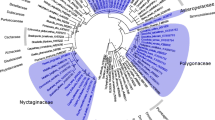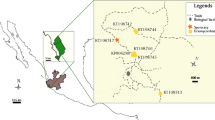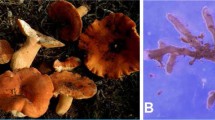Abstract
Abies religiosa is an endemic conifer of Mexico, where its monodominant forests are the winter refuge of the monarch butterfly. Due to climate change, it has been estimated that by 2090, A. religiosa populations will decline by 96.5 %. To achieve success, reforestation programs should consider its ectomycorrhizal (ECM) fungi. We used ITS nrDNA sequences to identify the ECM fungi associated with A. religiosa and, based on its abundance and frequency, determined the diversity and community structure in a pure A. religiosa forest near Mexico City. Using sequence metadata, we inferred the species geographic distribution and host preferences. We conducted phylogenetic analyses of the Clavulinaceae (the most important family). The ECM community held 83 species, among which the richest genera were Inocybe (21 species), Tomentella (10 species), and Russula (8 species). Besides its low species richness, the Clavulina-Membranomyces lineage was the most dominant family. Clavulina cf. cinerea and Membranomyces sp. exhibited the highest relative abundance and relative frequency values. Phylogenetic analyses placed the Clavulinaceae genotypes in three different clades: one within Membranomyces and two within Clavulina. A meta-analysis showed that the majority of the ECM fungi (45.78 %) associated with A. religiosa in Mexico have also been sequenced from North America and are shared by Pinaceae and Fagaceae. In contrast, because they have not been sequenced previously, 32.2 % of the species have a restricted distribution. Here, we highlight the emerging pattern that the Clavulina-Membranomyces lineage is dominant in several ECM communities in the Neotropics, including Aldinia and Dicymbe legume tropical forests in the Guyana Shield, the Alnus acuminata subtropical communities, and the A. religiosa temperate forests in Mexico.






Similar content being viewed by others
References
Ángeles-Argáiz RE, Flores-García A, Ulloa M, Garibay-Orijel R (2016) Commercial Sphagnum peat moss is a vector for exotic ectomycorrhizal mushrooms. Biol Invasions 18:89–101. doi:10.1007/s10530-015-0992-2
Altschul SF, Gish W, Miller W, Myers EW, Lipman DJ (1990) Basic alignment search tool. J Mol Ecol 215:403–410. doi:10.1016/S0022-2836(05)80360-2
Avis PG (2012) Ectomycorrhizal iconoclasts: the ITS rDNA diversity and nitrophilic tendencies of fetid Russula. Mycologia 104:998–1007. doi:10.3852/11-399
Bahram M, Kõljalg U, Courty PE et al (2013) The distance decay of similarity in communities of ectomycorrhizal fungi in different ecosystems and scales. J Ecol 101:1335–1344. doi:10.1111/1365-2745.12120
Bonito GM, Gryganskyi AP, Trappe JM, Vilgalys R (2010) Global meta-analysis of Tuber ITS rDNA sequences: species diversity, host associations and long-distance dispersal. Mol Ecol 19:4994–5008
Bringham MA, Simard S (2011) Ectomycorrhizal networks of Pseudotsuga menziesii var. glauca trees facilitate establishment of conspecific seedlings under drought. Ecosystems 15:188–199. doi:10.1007/s10021-011-9502-2
Burrola-Aguilar C, Garibay-Orijel R, Argüelles-Moyao A (2013) Abies religiosa forests harbor the highest species density and sporocarp productivity of wild edible mushrooms among five different vegetation types in a neotropical temperate forest region. Agrofor Syst 87:1101–1115. doi:10.1007/s10457-013-9623-z
Eckenwalder JE (2009) Conifers of the world: the complete reference. Timber press, London
Fa JE, Morales LM (1998) Patrones de diversidad de mamíferos de México. In: Ramamoorthy TP, Bye R, Lot A, Fa JE (eds) Diversidad biológica de México: orígenes y distribución. Instituto de Biología. UNAM, México, pp 315–352
García-Palomo A, Zamorano JJ, López-Miguel C, Galván-García A, Carlos-Valerio V, Ortega R, Macías JL (2008) El arreglo morfoestructural de la Sierra de Las Cruces, México central. Rev Mex Cienc Geol 25:158–178
Gardes M, Bruns TD (1993) ITS primers with enhanced specificity for basidiomycetes—application to the identification of mycorrhizae and rusts. Mol Ecol 2:113–118. doi:10.1111/j.1365-294X.1993.tb00005.x
Garibay-Orijel R, Morales-Marañón E, Domínguez-Gutiérrez M, Flores-García A (2013) Caracterización morfológica y genética de las ectomicorrizas formadas entre Pinus montezumae y los hongos presentes en los bancos de esporas en la Faja Volcánica Transmexicana. Rev Mex Biodivers 84:153–169. doi:10.7550/rmb.29839
Guindon S, Dufayard JF, Lefort V, Anisimova M, Hordijk W, Gascuel O (2010) New algorithms and methods to estimate maximum-likelihood phylogenies: assessing the performance of PhyML 3.0. Syst Biol 59:307–321
Hammer Ø, Harper DAT, Ryan PD (2001) PAST: paleontological statistics software package for education and data analysis. Palaeontol Electron 4:1–9
Horton TR, Bruns TD (2001) The molecular revolution in ectomycorrhizal ecology: peeking into the black box. Mol Ecol 10:1855–1871. doi:10.1046/j.0962-1083.2001.01333.x
Huelsenbeck JP, Ronquist F (2001) MRBAYES: Bayesian inference of phylogenetic trees. Bioinformatics 17:754–755
INEGI. Instituto Nacional de Estadística, Geografía e Informática (2011) Anuario estadístico del Estado de México. http://inegi.mx/est/contenidos/espanol/sistemas/aee11/info/mex/mapas.pdf. Accessed 14 May 2013
Ishida TA, Kazuhide N, Hogetsu T (2007) Host effects on ectomycorrhizal fungal communities: insight from eight host species in mixed conifer-broadleaf forests. New Phytol 174:430–472. doi:10.1111/j.1469-8137.2007.02016.x
Izzo A, Agbowo J, Bruns TD (2005) Detection of plot-level changes in ectomycorrhizal communities across years in an old-growth mixed-conifer forest. New Phytol 166:619–630. doi:10.1111/j.1469-8137.2005.01354.x
Jujnovsky J, González-Martínez TM, Cantoral-Uriza EA, Almeida-Leñero L (2012) Assessment of water supply as an ecosystem service in a rural-urban watershed in southwestern Mexico City. Environ Manag 49:690–702. doi:10.1007/s00267-011-9804-3
Katoh K, Toh H (2008) Recent developments in the MAFFT multiple sequence alignment program. Brief Bioinform 9:286–298. doi:10.1093/bib/bbn013
Kennedy PG, Garibay-Orijel R, Higgins LM, Ángeles-Argáiz R (2011) Ectomycorrhizal fungi in Mexican Alnus forests support the host co- migration hypothesis and continental-scale patterns in phylogeography. Mycorrhiza 6:559–568. doi:10.1007/s00572-011-0366-2
Kennedy PG, Matheny PB, Ryberg KM et al (2012) Scaling up: examining the macroecology of ectomycorrhizal fungi. Mol Ecol 21:4151–4154. doi:10.1111/j.1365-294X.2012.05703.x
Kong A, Cifuentes J, Estrada-Torres A, Guzmán-Dávalos L, Garibay-Orijel R, Buyck B (2015) Russulaceae associated with mycoheterotroph Monotropa uniflora (Ericaceae) in Tlaxcala, Mexico: a phylogenetic approach. Cryptogam Mycol 36(4):479–512. doi:10.7872/crym/v36.iss4.2015.479
Kranabetter JM, Durall DM, MacKenzie WH (2009) Diversity and species distribution of ectomycorrhizal fungi along productivity gradients of a southern boreal forest. Mycorrhiza 19:99–162. doi:10.1007/s00572-008-0208-z
Krzywinski M, Schein J, Birol I et al (2009) Circos: an information aesthetic for comparative genomics. Genome Res 19:1639–1645. doi:10.1101/gr.092759.109
Looney BP, Ryberg M, Hampe F, Sanchez-Garcia M, Matheny PB (2016) Into and out of the tropics: global diversification patterns in a hyperdiverse clade of ectomycorrhizal fungi. Mol Ecol 25:630–647
Larsson KH, Larsson E, Kõljalg U (2004) High phylogenetic diversity among corticioid homobasidiomycetes. Mycol Res 108:983–1002. doi:10.1017/S0953756204000851
Maddison WP, Maddison DR (2011) Mesquite: a modular system for evolutionary analysis. Version 2.75 http://mesquiteproject.org
Manzo-Delgado L, López-García J, Alcántara-Ayala I (2013) Role of forest conservation in lessening land degradation in a temperate region: the Monarch Butterfly Biosphere Reserve, Mexico. J Environ Manage. doi:10.1016/j.jenvman.2013.11.017
Matheny PB, Aime MC, Bougher NL, Buyck B, Desjardin DE, Horak E, Kropp BR, Lodge DJ, Soytong K, Trappe JM, Hibbett DS (2009) Out of the Palaeotropics? Historical biogeography and diversification of the cosmopolitan ectomycorrhizal mushroom family Inocybaceae. J Biogeogr 36:577–592
Meiser A, Balint M, Schmitt I (2014) Meta-analysis of deep-sequenced fungal communities indicates limited taxon sharing between studies and the presence of biogeographic patterns. New Phytol 201:623–635. doi:10.1111/nph.12532
McAleece N, Lambsshead P, Paterson G, Gage I (1997) Biodiversity Professional V2.0. The Natural History Museum and the Scottish Association for Marine Science, Argyll, Scotland
Miranda-Aragón L, Treviño-Garza EJ, Jiménez-Pérez J et al (2012) Modeling susceptibility to deforestation of remaining ecosystems in North Central Mexico with logistic regression. J For Res 23:345–354. doi:10.1007/s11676-012-0230-z
Montoya A, Kong A, Estrada-Torres A, Cifuentes J, Caballero J (2005) Useful wild fungi of La Malinche National Park, Mexico. Fungal Divers 17:115–143
Montoya A, Torres-García EA, Kong A, Estrada-Torres A, Caballero J (2012) Gender differences and regionalization of the cultural significance of wild mushrooms around La Malinche volcano, Tlaxcala, Mexico. Mycologia 1004:826–834. doi:10.3852/11-347
Morris MH, Pérez-Pérez MA, Smith ME, Bledsoe CS (2009) Influence of host species on ectomycorrhizal communities associated with two co-occurring oaks (Quercus spp.) in a tropical cloud forest. FEMS Microbiol Ecol 69:274–287
Nilsson R, Kristiansson E, Ryberg M, Hallenberg N, Larsson K-H (2008) Intraspecific ITS variability in the kingdom Fungi as expressed in the international sequence databases and its implications for molecular species identification. Evol Bioinform Online 4:193–201
Olariaga I, Jugo BM, García-Etxebarria K, Salcedo I (2009) Species delimitation in the European species of Clavulina (Cantharellales, Basidiomycota) inferred from phylogenetic analyses of ITS region and morphological data. Mycol Res 113:1261–1270. doi:10.1016/j.mycres.2009.08.008
Oberwinkler F, Riess K, Bauer R, Garnica S (2014) Morphology and molecules: the Sebacinales, a case study. Mycol Prog 13:445–470. doi:10.1007/s11557-014-0983-1
Pacheco-Cobos L, Rosetti M, Cuatianquiz C, Hudson R (2010) Sex differences in mushroom gathering: men expend more energy to obtain equivalent benefits. Evol Hum Behav 31:289–297. doi:10.1016/j.evolhumbehav.2009.12.008
Peay KG, Kennedy PG, Bruns TD (2008) Fungal community ecology: a hybrid beast with a molecular master. Bioscience 58:799–810. doi:10.1641/B580907
Peay KG, Bidartondo MI, Arnold AE (2010) Not every fungus is everywhere: scaling to the biogeography of fungal-plant interactions across roots, shoots and ecosystems. New Phytol 185:865–867
Posada D (2008) jModelTest: phylogenetic model averaging. Mol Biol Evol 25:1253–1256. doi:10.1093/molbev/msn083
Reverchon F, Ortega-Larrocea MP, Pérez-Moreno J, Peña-Ramirez VM, Siebe C (2010) Changes in community structure of ectomycorrhizal fungi associated with Pinus montezumae across a volcanic soil chronosequence at Sierra Chichinautzin, México. Can J For Res 40:1165–1174
Rudawska M, Pietras M, Smutek I et al (2016) Ectomycorrhizal fungal assemblages of Abies alba Mill. outside its native range in Poland. Mycorrhiza 26(1):57–65. doi:10.1007/s00572-015-0646-3
Ryberg M, Nilsson RH, Kristiansson E, Töpel M, Jacobsson S, Larsson E (2008) Mining metadata from unidentified ITS sequences in GenBank: a case study in Inocybe (Basidiomycota). BMC Evol Biol 8:50. doi:10.1186/1471-2148-8-50
Rzedowski J (1991) Diversidad y orígenes de la flora fanerogámica de México. Acta Bot Mex 14:3–21
Rzedowski J (2006) Capítulo 17. Bosque de coníferas. In: Rzedowski J (2006) Vegetación de México. First digital edition. Comisión Nacional para el Conocimiento y Uso de la Biodiversidad, Mexico, pp 295–327.
Sáenz-Romero C, Rehfeldt GE, Duval P, Lindig-Cisneros RA (2012) Abies religiosa habitat prediction in climatic change scenarios and implications for monarch butterfly conservation in Mexico. For Ecol Manag 275:98–106. doi:10.1016/j.foreco.2012.03.004
Setaro SD, Garnica S, Herrera PI, Suárez JP, Göker M (2012) A clustering optimization strategy to estimate species richness of Sebacinales in the tropical Andes based on molecular sequences from distinct DNA regions. Biodivers Conserv 21:2269–2285. doi:10.1007/s10531-011-0205-y
Schirkonyer U (2013) Ectomycorrhizal diversity at five different tree species in forests of the Taunus Mountains in Central Germany. Open J Ecol 3:66–81. doi:10.4236/oje.2013.31009
Sjökvist E, Pfeil BE, Larsson E, Larsson KH (2014) Stereopsidales—a new order of mushroom-forming fungi. PLoS One 9(4):e95227. doi:10.1371/journal.pone.0095227
Smith ME, Henkel TW, Catherine-Aime M, Fremier AK, Vilgalys R (2011) Ectomycorrhizal fungal diversity and community structure on three co-occurring leguminous canopy tree species in a Neotropical rainforest. New Phytol 192:699–712. doi:10.1111/j.1469-8137.2011.03844.x
Talbot JM, Bruns TD, Taylor JW, Smith DP, Branco S, Glassman SI, Erlandson S, Vilgalys R, Liaoc HL, Smith ME, Peay KG (2014) Endemism and functional convergence across the North American soil mycobiome. PNAS 111(17):6341–6346
Tse-Laurence MA, Bidartondo MI (2011) Mapping fungi from below ground: online genetic resources and ectomycorrhizal geographic distributions. iForest 4:252–255. doi:10.3832/ifor0599-008
Tedersoo L, May TW, Smith ME (2010) Ectomycorrhizal lifestyle in fungi: global diversity, distribution, and evolution of phylogenetic lineages. Mycorrhiza 20:217–263. doi:10.1007/s00572-009-0274-x
Tedersoo L, Abarenkov K, Nilsson RH, Schüssler A, Grelet WA, Kohout P, Oja J, Bonito GM, Veldre V, Jairus T, Ryberg M, Larsson KH, Kõljalg U (2011) Tidying up international nucleotide sequence databases: ecological, geographical and sequence quality annotation of ITS sequences of mycorrhizal fungi. PLoS One 6:e24940. doi:10.1371/journal.pone.0024940
Tedersoo L, Bahram M, Põlme S et al (2014) Global diversity and geography of soil fungi. Science 346:1078. doi:10.1126/science.1256688
Uehling JK, Henkel TW, Vilgalys R, Smith ME (2012) Membranomyces species are common ectomycorrhizal symbionts in Northern Hemisphere forests. Mycorrhiza 22:577–581. doi:10.1007/s00572-012-0457-8
Villela OF (1998) Herpetofauna de México: distribución y endemismo. In: Ramamoorthy TP, Bye R, Lot A, Fa JE (eds) Diversidad biológica de México: orígenes y distribución. Instituto de Biología. UNAM, México, pp 251–278
Ważny R (2014) Ectomycorrhizal communities associated with silver fir seedlings (Abies alba Mill.) differ largely in mature silver fir stands and in Scots pine forecrops. Ann For Sci 71:801–810. doi:10.1007/s13595-014-0378-0
Weiß M, Waller F, Zuccaro A, Selosse M-A (2016) Sebacinales—one thousand and one interactions with land plants. New Phytol 211:20–40. doi:10.1111/nph.13977
White TJ, Bruns TD, Lee S, Taylor J (1990) Amplification and direct sequencing of fungal ribosomal RNA genes for phylogenetics. In: Innis M, Gelfand D, Sninsky J, White T (eds) PCR Protocols: a guide to methods and applications. Academic Press, CA, USA, pp 315–322
Xiang Q, Xiang JQ, Guo Y, Zhang X (2009) Phylogeny of Abies (Pinaceae) inferred from nrITS sequence data. Taxon 58:141–152. doi:10.1046/j.0028-646x.2003.00792.x
Acknowledgments
This research was funded by the Universidad Nacional Autónoma de México grant PAPIIT-IN218210 and by the Consejo Nacional de Ciencia y Tecnología grant CONACYT-239266. AAM received from Consejo Nacional de Ciencia y Tecnología (CONACYT) two fellowships for graduate studies 314537 and 374558. This article is a requisite for AAM to obtain the PhD degree by the Posgrado en Ciencias Biologicas, UNAM. AAM offers recognition to Julieta Alvarez Manjarrez for her invaluable help in the phylogenetic analyses. We thank the contribution of two anonymous reviewers and the editor.
Author information
Authors and Affiliations
Corresponding author
Ethics declarations
Conflict of interest
The authors declare that they have no conflict of interest.
Electronic supplementary material
Below is the link to the electronic supplementary material.
ESM 1
(PDF 1581 kb)
Supplementary Table 1
(PDF 135 kb)
Supplementary Table 2
(PDF 165 kb)
Rights and permissions
About this article
Cite this article
Argüelles-Moyao, A., Garibay-Orijel, R., Márquez-Valdelamar, L.M. et al. Clavulina-Membranomyces is the most important lineage within the highly diverse ectomycorrhizal fungal community of Abies religiosa . Mycorrhiza 27, 53–65 (2017). https://doi.org/10.1007/s00572-016-0724-1
Received:
Accepted:
Published:
Issue Date:
DOI: https://doi.org/10.1007/s00572-016-0724-1




